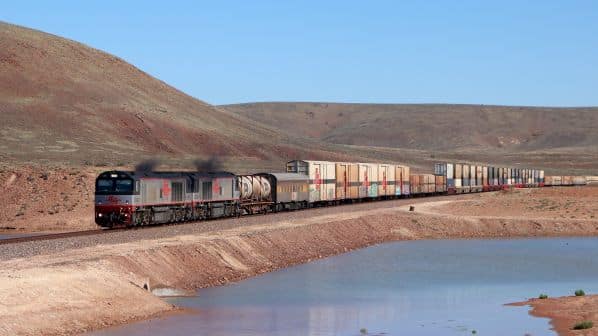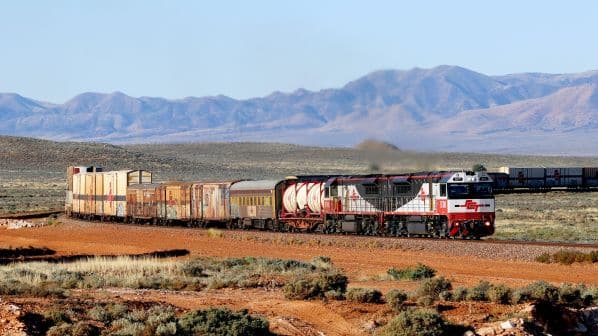PLAGUED by cost increases and an ever-lengthening project delivery schedule, Australia’s 1727km-long Melbourne - Brisbane Inland Rail project is facing uncertainty around its scope and future, raising doubts as to whether its original objectives will ever be met.
Inland Rail is being funded by the Australian government and managed by federally-owned infrastructure manager Australian Rail Track Corporation (ARTC), but an independent review into the project found major deficiencies in its governance and delivery.
Headed by Dr Kerry Schott, the review found that the project is running significantly over budget, with the estimated completion cost ballooning to $A 31bn ($US 19.7bn), and the project significantly behind schedule with only 16% of the route completed so far.
The revised cost estimate is double the previous estimate from 2020 and quadruple the original proposed cost, an increase described by Schott as “astonishing.”
“Somewhat surprisingly the project has commenced delivery without knowing where it will start or finish, with the final completion date and cost remaining uncertain because of a lack of confidence in the current estimates,” Schott said when the review was released in April.
The original plan was for Inland Rail to provide a dedicated freight route linking the ports of Melbourne and Brisbane, which would be superior to the poor alignments on existing corridors and avoid the congested path through Sydney. It would also provide an interchange with the main east-west transcontinental route at Parkes in New South Wales.
Inland Rail has been designed to accommodate 2km-long, double-stack intermodal trains with an end-to-end transit time of 24 hours.
Upgrades to existing tracks would account for around 1000 route-km with the remainder consisting of new construction on greenfield alignments. Initial cost estimates in 2010 were around $A 5bn, although this excluded the final 128km section of new build between Gowrie and Kagaru in Queensland.
This latter section, with numerous tunnels and viaducts, was anticipated to cost another $A 2-3bn, the expectation being it would be built by the private sector under a Public-Private Partnership (PPP).
But by 2017 the overall cost estimate had risen to $A 10bn, and three years later had again risen to $A 15bn, while the schedule for completion of the project had slipped by five years from 2023 to 2028.
This prompted the new Labor Party-led administration, which was elected in May 2022, to launch the Schott review.
“Dr Schott’s report is clear, Inland Rail is behind schedule, over budget and requires a fundamental reset.”
Catherine King, federal minister responsible for transport
However, despite the review’s grim outlook, the government confirmed that Inland Rail remains an important national project to meet Australia’s growing demand for rail freight, improve road safety and help decarbonise the economy.
“Dr Schott’s report is clear,” says the federal minister responsible for transport, Ms Catherine King. “Inland Rail is behind schedule, over budget and requires a fundamental reset.” Nevertheless, the Australian government says it is committed to the staged delivery of Inland Rail, prioritising completion of the southern section of the project between Beveridge in Victoria and Narromine in New South Wales by 2027.
The final report outlined 19 recommendations to improve the delivery of Inland Rail, which the government agreed to in full, or in principle.
A dedicated subsidiary of ARTC, Inland Rail Pty Ltd (IRPL), was created in July to manage the delivery of the project. An experienced and skilled six-member board was appointed to oversee the project in order to allow ARTC to focus on its core business of managing the wider interstate network. However, the project continues to be hindered by the fact that neither ARTC nor Inland Rail have had a permanent CEO for some time, although a global recruitment process is underway to fill both positions.
On October 18, Inland Rail announced that its acting chief executive, Ms Rebecca Pickering, had left the company after serving in this role for more than two years. Inland Rail says it has put in place interim arrangements while the recruitment process continues.
King says the government will consider delivery of the further stages of Inland Rail north of Narromine when the project has gained the required approvals to provide sufficient certainty that it can be built within budget and on time. “We have agreed to engage independent specialists to review the scope, design, delivery, and cost of the project to provide more certainty that it can be built to an agreed budget and timeframe,” she says.
As such, the effective southern terminus of Inland Rail will be at Parkes for the foreseeable future. While the upgrade of the section between Parkes and Narromine connects with the regional NSW network and has brought limited benefit to the transport of agricultural and mineral products from the region, it currently has no links to inter-state corridors.
There has been some development at Parkes in recent years, with both Pacific National and SCT investing in private terminals with Inland Rail in mind. There is also some potential with the east-west connection, but it is unlikely to reach its full potential until the full Inland Rail route is complete.

on the existing Melbourne - Brisbane corridor. Photo: Mark Carter
While the government’s focus on the southern half of the project is not unexpected, the northern half now appears to have been left in limbo, with the only two upgrades completed so far - the Parkes - Narromine and Narrabri - North Star sections - effectively marooned for the time being. Completing the connection between Narromine and Narrabri will require the construction of 309km of new railway which, given the government’s current strategy, has no firm budget or timescale for completion.
The upgraded section north from Narrabri to the current northern Inland Rail terminus of North Star does bring some benefit to agricultural producers, but the section beyond Moree to North Star has seen infrequent use in past years.
There has also been a major change in the overall aims of the project. While the line still has a targeted end-to-end transit time of 24 hours, this is now only expected to be between outer suburban terminals located at Beveridge, 50km from Melbourne, and Ebenezer, 80km from Brisbane.
Work is progressing on several of the southern projects, including upgrading parts of the existing Melbourne - Sydney inter state corridor that will ultimately form part of the Inland Rail route. This work includes lowering track under bridges to accommodate double-stack container trains.
Construction will also start next year on the 39km section from the east of Illabo north to Stockinbingal in New South Wales. The new line will bypass the township of Cootamundra and the steeply-graded section of track around the Bethungra Spiral and will be the first substantial piece of new infrastructure to be built as part of the Inland Rail project.
Industry impact
Mr Geoff Smith, managing director of freight operator SCT Logistics, which operates several weekly intermodal and box wagon trains on the existing Melbourne - Brisbane corridor via Sydney, says he supports the Schott review’s objectives in trying to bring clarity to the project scope including its end points. However, he says he has concerns regarding some of the findings that he feels will impact on the project’s success.
Smith says the proposal to locate the end terminals at Beveridge and Ebenezer would add to freight costs and impact the government’s decarbonisation agenda. “Terminal locations are critical in enhancing rail’s ability to compete with door-to-door deliveries,” he says. “The greater this distance, the more costly the task becomes and the greater the pressure on our road systems.”
Another concern for SCT is the review’s recommendation of favouring government-owned open-access terminals, where multiple operators work out of one terminal, combined with the removal of double stack capability beyond the proposed Ebenezer terminal. The review proposes that double-stacked containers would need to be transhipped to single-stack trains for the journey from Ebenezer to Kagaru, where Inland Rail would connect with the existing standard-gauge line to access the port of Brisbane.
“There needs to be a terminal outside the city where double-stack trains can manage their load and have the option to continue as single-stack beyond that point or switch to road haulage for the end of the trip,” Schott wrote in her review.
However, seven years ago SCT opened a freight terminal at Bromelton, on the existing ARTC mainline just south of Kagaru, with the capability to manage double-stack trains in anticipation of the opening of Inland Rail.
“These recommendations will reduce competition and the effectiveness of ours and other terminals including Bromelton in relation to Inland Rail,” Smith says. “Servicing the growing Gold Coast region, for example, would result in a 115km road journey from Ebenezer compared with 55km from Bromelton.
“To see this, seven years down the track, off the back of a government process that only took a few months to compile, is extremely disappointing. We are critical that the review seems to be steering rail and terminal operations back to an open-access model, which has failed in the past.”
Smith says that in the Australian context, open-access has ironically led to monopolised, single-operator outcomes, adding that the Victorian government’s original plan for Melbourne’s Inland Rail terminals was a superior approach.
“Given the cost of the project and reported costs around developing terminals at Beveridge and Ebenezer, it’s difficult to understand the logic in trying to exclude private-sector terminals from competing against government terminals which are as yet unbuilt,” Smith says.
There can be no doubt the current government had to take action to reign in the runway cost of the Inland Rail project and the review that it commissioned has made some tough recommendations.
However, with such a gross underestimation of the costs and scope of the project to date, it is hard to see where the political support will come from in the near future, and no doubt over several electoral cycles, to commit the funding needed to see the project through to its conclusion.

